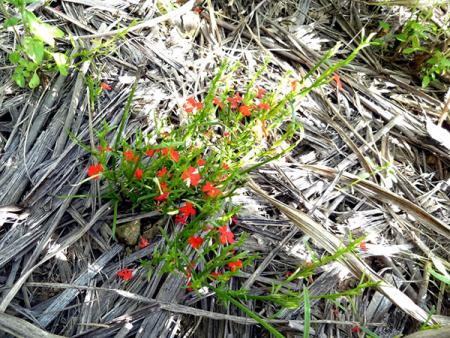Red witchweed (Striga asiatica) is exotic to Australia and is a serious threat to agriculture.
It is a parasitic plant that grows attached to the roots of commercially important grasses and cereal crops. These include sorghum, wheat, corn, rice, and sugarcane.
Detection in Australia
Red witchweed was detected on a sugarcane property near Mackay, Queensland, in July 2013. Extensive surveillance following this detection identified a total of 8 infested properties.
Response program
The Queensland Department of Primary Industries (DPI) leads the eradication program.
Costs of the eradication response are shared by the Australian Government, state and territory governments, and affected industries. The Queensland Government contributes extra resources and funding to the program.
A response plan is in place that aims to eradicate red witchweed. The plan covers all aspects of the response including:
- a surveillance and monitoring program
- treatment to eradicate the weed at infested sites
- movement restrictions at high-risk sites and on potential host material
- monitoring after treatment of infested areas to ensure they are free of red witchweed.
The response program has led to a 99% reduction in red witchweed detections in infested areas. Treatment has been completed at 6 of the 8 affected properties.
The program will continue treatment at the remaining 2 properties during 2025-26. Once treatment is complete, the program will continue in a monitoring phase to provide assurance that the weed has been successfully eradicated.
See more
How we coordinate a response to an outbreak.
Red witchweed (Queensland DPI)
Your obligations
Check susceptible crops regularly for red witchweed. This is especially important if you live or work near the affected area in Queensland or if you have travelled to, or bought equipment from, overseas.
Observe good farm biosecurity practices: avoid moving soil, machinery, and products such as mulch that might contain red witchweed seeds. Always check and wash clothes, boots, and equipment. This will stop the spread of red witchweed to other properties.
Report sightings
Report any unusual weeds, even if you’re not sure. Do not attempt to remove any flowering red witchweed plants. This may allow the tiny, dust-like seeds to spread.
In Queensland you can report using the online form or by calling Queensland DPI on 13 25 23.
To report suspected red witchweed from anywhere in Australia call the Exotic Plant Pest Hotline on 1800 084 881 .
For signs of exotic pests and diseases in imported goods, sea containers or parcels, call See. Secure. Report on 1800 798 636 or use the online form.
Follow the rules
Keep exotic dangerous pests and diseases out of Australia. Never ignore our strict biosecurity rules.
Import shipments may need to be treated and certified. Before you import, check the Biosecurity Import Conditions (BICON) system.
Movement restrictions
Movement restrictions are in place at infested sites. You must adhere to them. They ensure the weed is not spread further.
See details of movement restrictions in Queensland.
About the pest
Red witchweed is a parasitic plant. It grows attached to the roots of host plants. Affected crops include sorghum, millet, corn, rice, and sugarcane. Wheat and barley are also potential hosts.
Red witchweed grows in tropical and subtropical climates and is native to parts of Africa, Arabia, and Asia. It can survive in a range of soils, although it grows more readily in free-draining sandy or gravelly soils.
What to look for
Red witchweed plants are about 10-40 cm tall. They can have red, white, yellow, or pink flowers. The tiny seeds are borne in pods. A single plant can produce between 25,000 and 200,000 seeds.

See more at Red witchweed factsheet (Queensland DPI).
How it spreads
Red witchweed seeds are tiny and can be spread on vehicles, machinery, clothing, and boots. They can contaminate mulch, fertiliser and plant material. They can also spread by wind and water.
Impacts
Red witchweed survives by taking the host’s water and nutrients and can reduce crop yields by up to 70%.
Host plants may show stunted growth, wilting and yellowing of leaves. These symptoms can be confused for drought damage, nutrient deficiency, or disease.
Several of Australia’s trading partners consider red witchweed a quarantine pest. They’ve put conditions in place for a range of our seed and grain exports to address the risk.
Resources
- Red witchweed eradication program Queensland DPI
- Red witchweed factsheet Queensland DPI
- Farm Biosecurity Australia